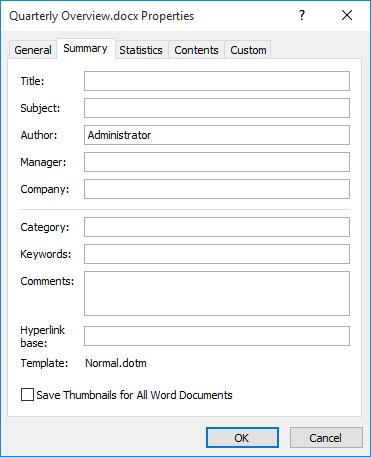Please Note: This article is written for users of the following Microsoft Word versions: 2007, 2010, 2013, 2016, 2019, and 2021. If you are using an earlier version (Word 2003 or earlier), this tip may not work for you. For a version of this tip written specifically for earlier versions of Word, click here: Blocking the First Sentence from File Info.
Written by Allen Wyatt (last updated June 1, 2019)
This tip applies to Word 2007, 2010, 2013, 2016, 2019, and 2021
Suppose you want to type a Word document and save it, password protected. Suppose further that you intended the first sentence to capture the intended reader's attention, but you didn't want the entire world to read it.
You chose "Save As" so that you could use the Tools drop-down and the Security Options to set a password. You notice that most of your inflammatory first sentence has been placed into the filename field by default as Word always does, so you highlight the incriminating phrase and give your document a new, innocuous name. You save it to the Desktop.
Now minimize all windows and go to the Desktop. Hover the mouse pointer over the icon for your new file. Up pops a window that shows the type, author and size, and, for good measure, right there in plain text for the world to see, most of the first sentence of your document—no password required!
What you are actually seeing when you hover the mouse over the icon is the document's title. This title is displayed automatically, unless you have an older version of Windows that doesn't display information balloons about files. While you can hack the Windows registry to turn off the balloons, it is easier to just get rid of the title within Word. You do this by displaying the Properties dialog box for the document, and how you get to that dialog box differs based on the version of Word you are using.
If you are using Word 2010 or later version, follow these steps:
If you are using Word 2007, follow these steps:
Regardless of which version of Word you are using, you can now follow these steps:

Figure 1. The Summary tab of the Properties dialog box.
The Title property is set automatically when you first save a document. Word puts the initial document text (up to the first punctuation mark) in the Title property and uses the same text as a suggested file name. Changing the file name when you save the document does not result in the Title property being changed; you must do it separately, as described above.
WordTips is your source for cost-effective Microsoft Word training. (Microsoft Word is the most popular word processing software in the world.) This tip (6268) applies to Microsoft Word 2007, 2010, 2013, 2016, 2019, and 2021. You can find a version of this tip for the older menu interface of Word here: Blocking the First Sentence from File Info.

Learning Made Easy! Quickly teach yourself how to format, publish, and share your content using Word 2021 or Microsoft 365. With Step by Step, you set the pace, building and practicing the skills you need, just when you need them! Check out Microsoft Word Step by Step today!
One way you can designate your responsibility for a document is to add your phone number to it. There is no need to add ...
Discover MoreDocument properties are used to define metadata that is stored with a document. If you need to often set document ...
Discover MoreWord maintains a collection of descriptive properties for each document you create. One of these properties is the Title ...
Discover MoreFREE SERVICE: Get tips like this every week in WordTips, a free productivity newsletter. Enter your address and click "Subscribe."
2019-06-03 12:13:58
Simon Freeman
Allen - I don't seem to get the document title showing when I hover the mouse over a Word file in the Desktop. I am using Windows X.Also (my version of) Word 2010 doesn't seem to be saving the first words of a document into the filename either. - Any ideas.
Got a version of Word that uses the ribbon interface (Word 2007 or later)? This site is for you! If you use an earlier version of Word, visit our WordTips site focusing on the menu interface.
Visit the WordTips channel on YouTube
FREE SERVICE: Get tips like this every week in WordTips, a free productivity newsletter. Enter your address and click "Subscribe."
Copyright © 2026 Sharon Parq Associates, Inc.
Comments